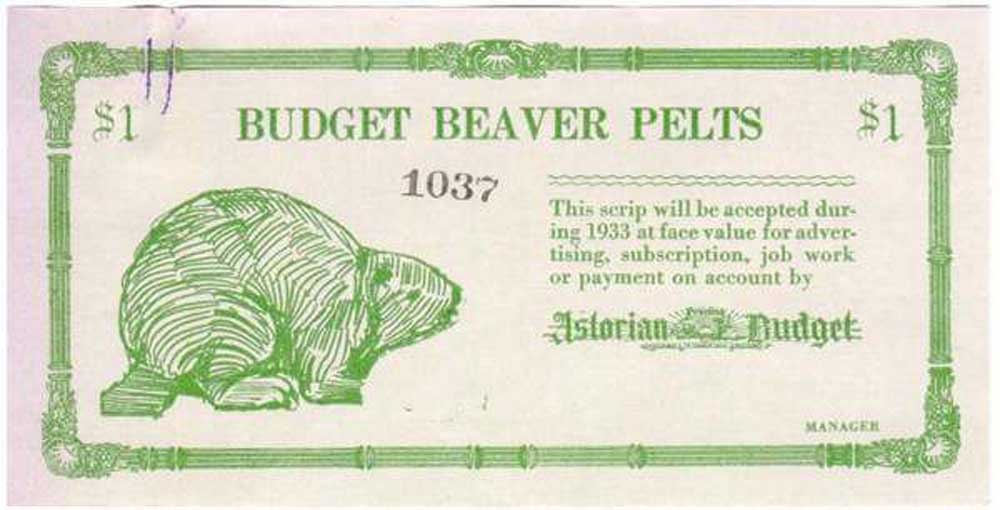Fire devastates Astoria, followed by economic calamity and World War II
Published 10:17 am Wednesday, June 19, 2019

- The Astorian-Budget offered its own scrip, Budget Beaver Pelts, during the Depression
Throughout its history, the owners of the East Oregonian Publishing Co. have faced adversities, large and small. During the first half of the Twentieth Century, the Great Astoria Fire and the Great Depression were among the most serious.
By 1920, Astoria was the third largest city in Oregon. In short order, Chessman and Drake doubled the paper’s circulation and grew its revenues.
On December 8, 1922, disaster struck when a fire destroyed most of the town’s commercial district, including 32 blocks and 240 businesses. The loss to Astoria came to approximately $15 million. Lee Drake and Merle Chessman worked frantically to save the new Astoria Budget building.
Showing great pluck under Chessman’s and Drake’s leadership during the emergency, the Budget staff shifted to the Astoria YMCA building—one of the few that escaped destruction—and used a multigraph machine to get out the December 8 issue. The next day, a page-one editorial in the rival Morning Astorian called upon the citizens of Astoria to rebuild: “Let every citizen unite with the common purpose to advance, to grow again; let none lag; let none be dismayed. Every Astorian should echo the cry of those, who called upon to do the impossible and dare the utmost on an embattled front in a foreign land, made their slogan of two simple words: ‘Lets Go.’”
At the end of this decade, the company would face the Great Depression. Banks failed, businesses went broke, and high unemployment added to the misery caused by the struggling agricultural and timber sectors of Oregon’s economy. Soon 90 percent of the Oregon’s timber companies were on the edge of bankruptcy and one-half of all state timber land became tax delinquent. The state’s farm income plummeted from $136 million in 1929 to $49 million in 1933. Delinquencies on the county and local tax rolls reflected financial suffering and curtailed support for schools and various community services. Private relief efforts quickly became overwhelmed throughout Oregon. Pendleton and Astoria did not escape the tough times.
The collapse in farm prices weighed especially heavily on the Pendleton community. To get around the lack of cash when the banks closed, Chessman adopted a novel approach. The AB issued its own scrip, known as the “Budget Beaver Pelts.” As Merle Chessman explained, “It was just a temporary expedient but it worked out very well. We’re getting some bills paid thereby which would be unpaid as yet. We issued 50 per cent of the payroll a week ago in scrip and 25 per cent today and also paid the carriers 50 per cent. In all we have issued about $650 in scrip and it is returning to us at a lively pace. Practically all of the business houses accepted it at face and numbers of them gave back cash change.”
What neither the East Oregonian nor the Astoria Budget did was to panic and engage in journalistic sensationalism merely to survive. They both maintained their reputation for editorial quality and accurate news coverage, while preserving such staples as sports and women and society sections.
No sooner had the East Oregonian and Astoria Budget escaped the debilitating effects of the Depression, than they descended into the unknown perils of operating under wartime conditions. The nation’s entry into World War II presented a whole new set of challenges to the business of running a small-town, daily newspaper. With war came manpower shortages and then the rationing of newsprint.
Throughout the hard times of the 1930s and the drama of wartime in the 1940s, Aldrich and Chessman, in their respective papers, editorially continued to promote those actions they thought would better their communities. Aldrich kept up his fight for a dam on the Columbia River at Umatilla Rapids. He argued forcefully that the dam construction would provide needed jobs while improving navigation and producing cheap electric power. It would materialize as McNary Dam.
To get around the lack of cash, the Astoria paper created a scrip, called Budget Beaver Pelts.





